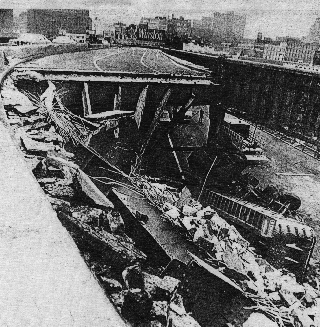Ice falling from the CNN tower in Toronto has led to the closure of the elevated Gardiner Expressway in downtown Toronto. This highway, It’s said, carries some 200,000 cars per day.
In times like these one has to wonder: is Mother Nature trying to tell us something?
Manhattan’s elevated West Side highway fell down in 1973.

It carried 80,000 cars per day. The city studied where those cars went and found the city absorbed the loss of infrastructure without significant changes to the rest of the grid. In other words, 80,000 trips a day disappeared (the link is to an interview with “Gridlock Sam” Schwartz, who undertook the studies on behalf of the New York Department of Transportation. Our colleagues over at “Stayfree” e-magazine have transcribed an interview that New York’s Streetsblob put up on its website).
Hope someone’s paying attention to the situation at the gardiner.
Schwartz: One of my first assignments was racing out to the West Side Highway [formerly Miller Highway] when it collapsed; this was an elevated platform that fell to the ground. We were hired to measure the impact on traffic. I put traffic counters all across the avenues and traced the diversion; it went to the FDR Drive and to the West Side avenues. But over time, we didn’t see any increase in traffic: the other avenues absorbed it and we weren’t able to trace it.
Q: So a big highway disappears and the traffic increase on other streets was barely measurable?
Schwartz: Yes, a highway carrying 80,000 vehicles a day collapsed and… nothing. We couldn’t even measure a change in speeds!
Riding a bike to work these past couple days has been a slog here int Toronto. My ride, a leisurely half hour into the prevailing westerly wind in the morning, and home into the northeasterly storm winds at the end of the day, has its ups and downs. But one thing anyone who writhes a bike will tell you is the time it takes is consistent. Cyclists are not affected by gridlock. The clots that stop cars in their tracks don't affect us. If necessary we can always get out of the saddle and walk a block. We can scoot up on the empty sidewalks of the CBD after the worker drones have gone to bed and get around what would be an impasse for someone in a car.
So we've been interested to see the way the downtown streets were affected by the shutdown of the Gardiner.
Fact is, they were worse than usual, but people got to work. Two hundred thousand cars a day were displaced from their normal route and the city went on more or less as normal.
Let's' just do it. Tear down the Gardiner.